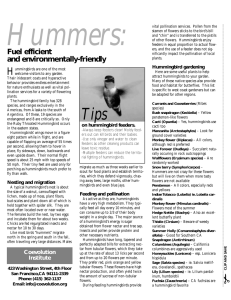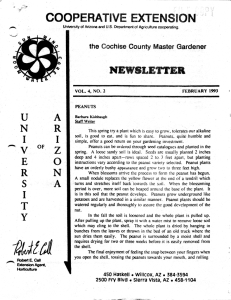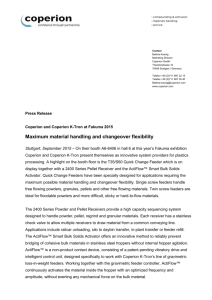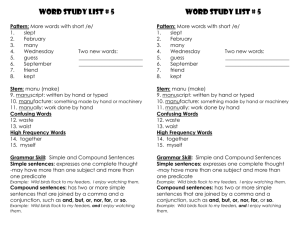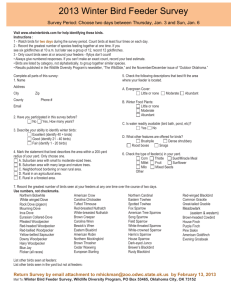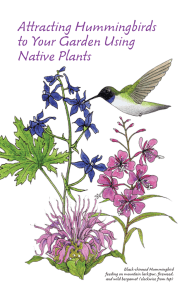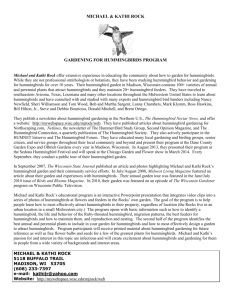One good way to enjoy the company of hummingbirds is planting a
advertisement
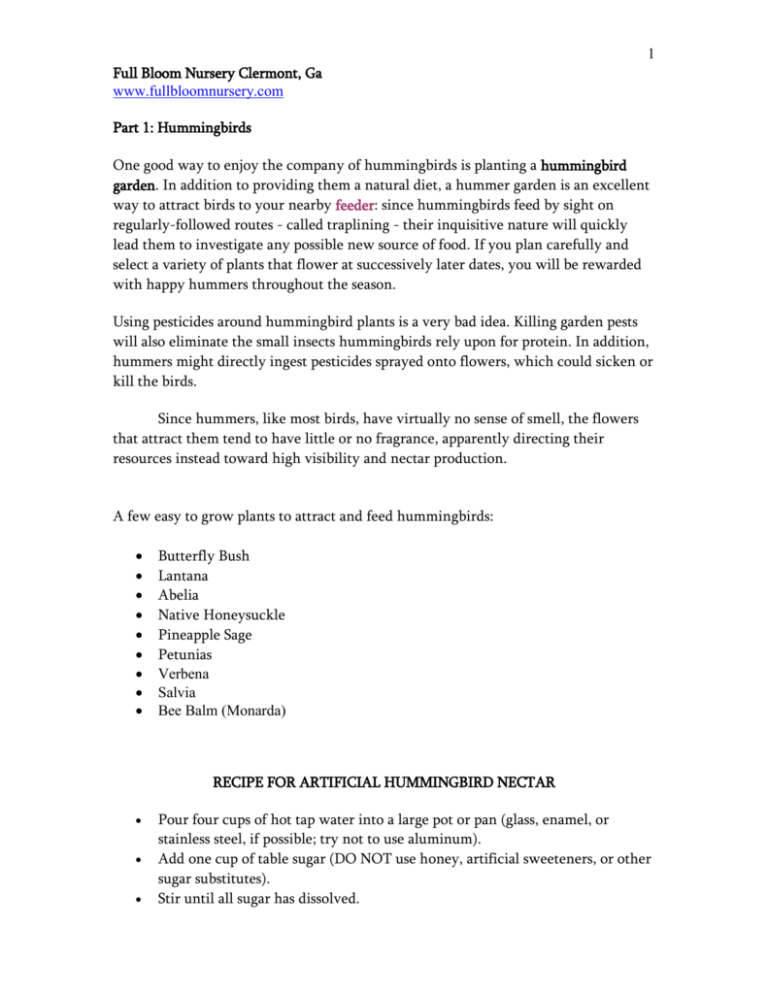
1 Full Bloom Nursery Clermont, Ga www.fullbloomnursery.com Part 1: Hummingbirds One good way to enjoy the company of hummingbirds is planting a hummingbird garden. In addition to providing them a natural diet, a hummer garden is an excellent way to attract birds to your nearby feeder: since hummingbirds feed by sight on regularly-followed routes - called traplining - their inquisitive nature will quickly lead them to investigate any possible new source of food. If you plan carefully and select a variety of plants that flower at successively later dates, you will be rewarded with happy hummers throughout the season. Using pesticides around hummingbird plants is a very bad idea. Killing garden pests will also eliminate the small insects hummingbirds rely upon for protein. In addition, hummers might directly ingest pesticides sprayed onto flowers, which could sicken or kill the birds. Since hummers, like most birds, have virtually no sense of smell, the flowers that attract them tend to have little or no fragrance, apparently directing their resources instead toward high visibility and nectar production. A few easy to grow plants to attract and feed hummingbirds: Butterfly Bush Lantana Abelia Native Honeysuckle Pineapple Sage Petunias Verbena Salvia Bee Balm (Monarda) RECIPE FOR ARTIFICIAL HUMMINGBIRD NECTAR Pour four cups of hot tap water into a large pot or pan (glass, enamel, or stainless steel, if possible; try not to use aluminum). Add one cup of table sugar (DO NOT use honey, artificial sweeteners, or other sugar substitutes). Stir until all sugar has dissolved. 2 Cover the pan, place on a hot burner, and bring the mix to a rolling boil for 1-2 minutes; be careful not to let water evaporate (if you do, the mix can become too concentrated). Let mix cool and pour into in well-cleaned feeders. Boiling, which retards mold growth, is NOT necessary if your hummingbirds are draining the feeders within three days. Red food coloring is unnecessary, especially after birds have found the feeders; besides, modern hummingbird feeders all have red plastic bases and/or yellow flowers the birds can easily see. NOTE: There is no evidence that food coloring currently available in grocery stores or in commercial hummingbird nectar mixes is harmful to humans or to hummingbirds, but it IS an additive. Store excess mix in the refrigerator for up to 2 weeks (check for fermentation or mold; if the mix is cloudy, discard it). Some people freeze their mix and safely store it for much longer periods. In any case, let mix warm to room temperature before filling feeders. The water:sugar ratio of 4:1 is typical of the sugar concentration found in many flowers used by hummingbirds. There is no concrete evidence stronger sugar concentrations will hurt hummingbirds, but even a 3:1 mix spoils much faster than 4:1, and 2:1 is too syrupy and a real waste of sugar. MISCELLANEOUS NOTES Put feeders up by mid-March to attract early migrants. DON'T wait until you see your first Ruby-throated Hummingbird of the spring, which may be well after the first ones arrive. Early in the season just fill feeders one-third full; no need to waste sugar water until hummers start draining the feeder. Likewise, as the season winds down, re-load each feeder with less sugar water. Maintain feeders all summer; take most down by 1 October, but leave one up until Thanksgiving (or even later if you can keep the mix from freezing); stray hummingbirds from the western U.S. may wander in and stay all winter Leaving feeders up will NOT influence when healthy Ruby-throated Hummingbirds migrate south; their departure (and spring arrival) is linked to photoperiod. In cool spring or fall weather, you may be able to go a week without changing the mix, but if it gets cloudy, throw it out. Clean and refill feeders at least twice weekly in hot weather. You wouldn't feed your house pets or your children moldy food, so follow the same policy with your hummingbirds. A mild solution of white vinegar may be used to kill mold in feeders for weekto-week cleaning. Invest in a curved bottle brush that can reach all parts of your feeders; it's also useful to have a pipe cleaner or small brush that will fit 3 into the feeder holes. Recent research indicates that bleach and other alkaline cleaners can release toxins from polycarbonate plastics used in some feeders; thus, chlorine bleach is not recommended as a cleaning agent. If you go on vacation or miss a week putting out feeders, don't feel sorry for the birds; Ruby-throated Hummingbirds know other food sources for at least a mile in all directions. Hang feeders in the shade when possible, but put them in full view of a window--especially one near your breakfast or supper table! If two or more feeders are used, put them where birds at one feeder can't see the other. Several 8- or 16-ounce feeders are far better than one or two large ones. Don't worry if Ruby-throated Hummingbirds spend a lot of time drinking artificial nectar; they also visit flowers for natural nectar and also catch small insects. It is unnecessary to buy fancy prepared mixes with vitamins and other additives; besides, these mixes cost as much as 20 times more than regular table sugar, and many of them contain preservatives that hummingbirds don’t need to be ingesting. Do NOT use insect spray or pesticides to keep bees and wasps off feeders; these chemicals may be fatal to small hummingbirds. A shallow saucer of 1:1 sugar water in the sun will often lure these insects away from hummingbird feeders NEVER use any petroluem-based product (Vaseline, Tanglefoot, Vicks, Metholatum, etc.) to keep insects away from feeders. These products are water-insoluble and can gum up the feathers of hummingbirds. Try hanging your hummingbird feeder from a coat hanger wire. Straighten the hanger except for the hook, which will hook over your roof gutter. Then bend the last 10" at the other end of the wire at a right angle, but leave a small dip where the feeder will hang. Coat hanger wire seems to be just the right diameter for a Ruby-throated Hummingbird's foot, so hummers often will perch on it and allow extended views and close-up photography. Part 2: Songbirds Understanding a bird's preferences will help you determine which plants to grow. Different plants will provide for different needs, whether that bounty is in the form of seeds, fruits, nuts, or nectar, as well as for a host of plant-munching caterpillars and 4 insects. A garden filled with a mixture of plants producing flowers, seeds, berries, and nuts will always attract the largest number and variety of birds. As a bonus, birds are the gardeners best friend in the war against summer insects. For example, seed-eating birds, including goldfinches, chickadees, and towhees, will seek out seed heads from an assortment of flowering plants and ornamental grasses. Any daisy-like flowers such as sunflowers, asters, and black–eyed Susans, in addition to rudbeckias, zinnias, and echinaceas, would be good choices. Finches, sparrows, and nuthatches are a few of the birds that will flock to marigolds, cosmos, coreopsis, goldenrod, phlox, and a wide selection of salvias. Remember, too, that birds are attracted to seasonal food. They will stay longer in your garden if it contains plants that flower or fruit at different times of the year. For example, hollies and cotoneaster provide winter fruit. Serviceberries offer late spring berries. Blueberries and blackberries bear summer fruit. Crabapple, beautyberry, and pyracantha round out the fruit season in the fall. Shelter Plants that provide shelter—a safe haven from predators, protective cover from harsh weather, or a cozy spot, whether to nest or just settle in for the night—appeal to just about any bird, regardless of food preference. But a plant that provides food and shelter says, "Come on in." Pine trees provide evergreen shelter enjoyed by many birds as well as nourishing pine seeds favored by chickadees. Low-growing junipers not only hide birds from imminent danger, but also offer an insect buffet for ground–insect feeders such as wrens, towhees, and juncos, in addition to providing a bevy of berries for titmice and waxwings. As you develop your garden, consider grouping your plants in layers. You'll be creating a multilevel habitat of food and shelter for a variety of birds, whether they feed on the ground, in trees and bushes, or in the air. Include fruit-bearing shrubs, deciduous trees, and evergreens of all heights in your upper layers. At ground level, consider planting ground covers as well as petite perennials and annuals. Fill the layers in between with perennials, annuals, ornamental grasses, and low-growing shrubs. 5

